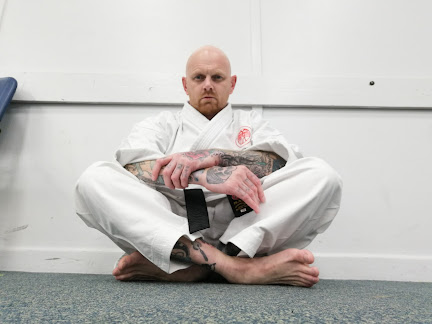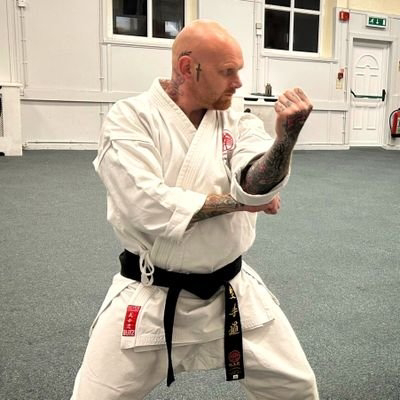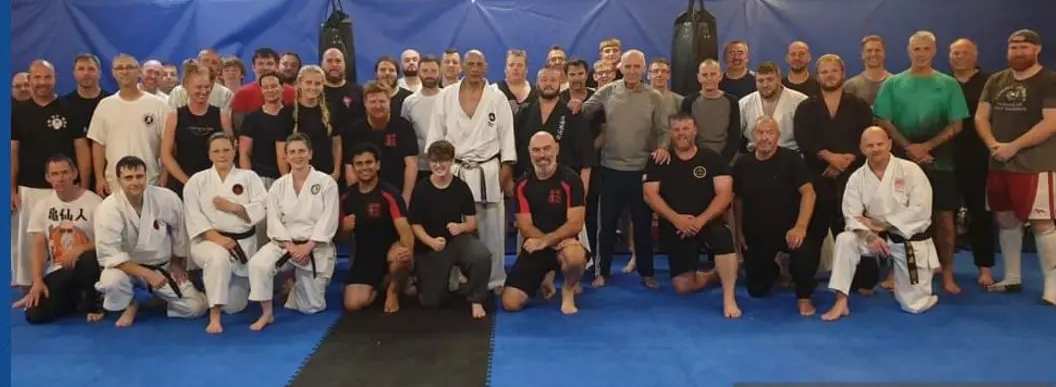Introduction
Hello, and welcome to Eye Of The Storm Martial Arts blog. My name is Rich Hobson, I'm 47 and I live in Bradford, West Yorkshire. I've read many martial arts biographies over the years, and more recently I have been listening to various martial arts podcasts. Often, when listening to people being asked questions about their martial arts experiences, this triggers my own internal monologue as I start to think how I would answer those questions, should I ever be asked. It lead to me thinking that, if I start to write some of my own thoughts, ideas, stories and experiences in a blog, then it is out there for other people to read, should they wish. This is my first entry, please keep an eye out for future posts.
Why Eye Of The Storm? I was recently teaching some Kyu Grades defence against Mawashigeri (roundhouse kicks) and how to move into the attacker, rather than to step back. By stepping back, you may be placing yourself in the path of the foot, which is the part of the kicking leg that has the most momentum, and is likely to do the most damage. By closing the distance, and intercepting the kick at the thigh, where there is the least momentum, you have effectively taken the sting out of the kick. The same principle applies against an attack with a stick, or a bat. Don't be at the heavy end, move inside the bat's sweeping arc, and it loses it's power. When demonstrating this principle, I say 'This is where you want to be - right here, in the eye of the storm'. Not only does that describe the 'safe zone' right there in the centre of the attack, but also serves as a metaphor for all martial arts training. By staying calm, and focused, in a dangerous situation, you can effectively create a safe spot for yourself in the centre of the mayhem around you. Like many martial arts philosophies, the same principle carries over into everyday life; your home, workplace, relationships and family. Always try and be the calm amidst the storm.
So, without further ado, here's the story of my martial arts journey...
I first started training in martial arts back in 1998. Since then my journey has taken some ups, some downs, some twists and turns, a few false starts, some years of intense training, some years of no training, and a bag for life full of various coloured belts. It would take until 11th February 2023 before I finally received my coveted black belt. I have had that belt one year today, so it seems fitting that today should see me write my first blog post.
Back in 1998 I started training in Japanese Ju Jitsu under Sensei Steve Barnett, of Goshin Ryu Ju Jitsu Kai, in Harrogate, North Yorkshire. I was hooked after my first session, and very soon became a regular at the Goshin Ryu Dojo. Sensei Barnett was, and still is, an excellent martial artist, who taught his own brand of no-nonsense self defense based Ju Jitsu. At the time Sensei Barnett was a 7th Dan in Ju Jitsu, but also had a lot of experience in Wadu Ryu Karate, so taught karate strikes alongside Ju Jitsu techniques. I trained as often as I could for two years, and got to blue belt. In September 2000 I went back to full time college as a mature student. During this time, I was working evenings in a bar, and having two young children, I had to put my training on hold. I returned to the Goshin Ryu Dojo in 2003 until late 2004, gaining my purple belt, before events put an end to that chapter in my training.
The Goshin Ryu Dojo was being moved from a nearby school, to an army camp some miles out of town, I didn't drive, and would have struggled to get there. I was looking to move back to my hometown of Leeds around that time, and searching for a house, and a new job, took priority. I would look for a new Dojo once I was settled.
Once re-located in Leeds, I started looking for a Dojo that offered a similar style of Ju Jitsu that I was familiar with. Brazilian Jiu Jitsu was taking off in a big way, but I couldn't find anywhere local that did Japanese Ju Jitsu. The internet was still in it's early stages, and many clubs didn't have an online presence like they do today. I felt disheartened, and gave up my search until 2007.
By 2007, I still hadn't found a local Ju Jitsu Dojo, so I started thinking about other martial arts. What transferable skills had I learned that I could carry over into a new martial art? Karate! Sensei Barnett had already taught me Karate stances, punches, kicks and blocks. I already knew Japanese terminology and correct Dojo etiquette. It was time to start my Karate training!
I learned of a Shotokan Karate club nearby, by the name Zanshin Kai of Great Britain. Zanshin Kai was an organization headed up by Sensei Mick Burnand, and old school Karateka who had been training since the 70's, and was around during the Golden Era of Karate in the UK, fighting alongside Terry O'Neil, Steve Cattle and Frank Brennan. Sensei Burnand was an ex Marine, who had taught and competed in Karate in the army, as well as in civvy street, in the UK, Japan and in America. Sensei Burnand had produced a number of great Karateka over his career, many of whom had gone onto open their own clubs under the Zanshin Kai banner. These ex students came back to the Zanshin Kai Dojo at Clapgate School once a week to train alongside Sensei's senior black belts. I was the only Kyu grade in the class. It was decided that, so I wasn't holding back the senior grades, I would be taken into a separate room and receive one-to-one coaching. I would bow in with the rest of the class, do some basic Kihon, then I would be taken aside for an hour and I would be taught the Heian / Tekki Katas, before re-joining the class for the last half hour. The one-to-one coaching was given by Sensei John Leadbetter, and inspirational Karateka who was registered blind. Despite having only partial sight, Sensei Leadbetter could spot even the slightest deviation from correct form. I will always be grateful for the hours Sensei Leadbetter gave to teach me. This went on for about a year, until I was up to speed, and ready to join the main class. I trained at Zanshin Kai for three and a half years, gaining purple and white belt (4th Kyu) before leaving due to a life changing job offer in 2011. The job involved uncertain finish times, as well as a long commute, so getting to the Zanshin Kai Dojo for 7pm was just impossible. Not wanting to drop training completely, and feeling ready for a change, I found an Aikido club that trained late.
Ichiban Aikido Club was run by Sensei Bob Jones. A likeable man that didn't stand on ceremony. He didn't expect students to bow when they addressed him, and he much preferred to be called Bob than Sensei. Despite his casual demeanour, Sensei Jones's credentials were serious enough. I believe that, at the time, Sensei Jones was a 9th Dan, and head coach for the British Tomiki Aikido Team, many of whom trained there at the Ichiban Dojo in Leeds. I trained there from 2011 to 2012, but decided that Aikido wasn't for me. Aikido is a beautiful, flowing martial art, but I found it a little too passive, I had grown to love striking arts.
By now, I was settled into my new career, and had moved base closer to home. I was starting to think about what I really wanted from my martial arts training. I wanted a bloody good workout, some practical self defence skills, and an opportunity to practice sparring. Someone suggested Kickboxing. I joined a nearby Kickboxing club, run by Philip Garforth. It was a small club, part of the PKA Kickboxing organization. There were only about eight members, and on some nights, only four or five would turn up. We would start with a rigorous warm up, some core work, skipping, onto some padwork drills and end with some light contact sparring. It was fun while it lasted, but unsurprisingly the PKA didn't see it as a viable business model, and closed it in early 2014.
If you're still reading this, then thank you. It's a long winded story, and as I explained early on, a story full of ups, downs, twists, turns and false starts. Another chapter ended, more coloured belts in the old bag for life, and once again, I was faced with the dilemma of what to do next. I decided to take a break from martial arts training, and join the gym!
One day in 2017 I was taking my youngest daughter swimming and decided that instead of our usual swimming baths, I'd try a different one. After swimming, on our way out I saw a banner for a Jiu Jitsu class that was held there in the sports centre. I'd had a few years off the mats, and was inspired to make a return. The club was a member club of The Jiu Jitsu Foundation, and taught a mix of traditional Japanese styles mixed with more modern BJJ styles. Work was slow, and I immersed myself in my training, for about a year, until another life changing job offer came. Jiu Jitsu is a wonderful martial art, and I enjoyed it immensely, but it's complicated. If A, then do B. If X, then do Y. If they counter Y, then do Z. If they counter Z, revert back to B. There are many, many techniques in Jiu Jitsu, and when I was young and carefree, I enjoyed the myriad of presure points, numerous joint locks, various throws, take downs, hold downs, chokes and strangles. But now, with a heavy workload and lots going on in my head, I was starting to miss the relative simplicity of Karate!
I stopped training at TJJF in 2018 whilst concentrating on my new job. My new job meant I could now afford to save for a deposit on a house, and I moved from Leeds to Bradford, where I now live, with my wife, Gill. To keep in shape, I joined a gym, who were running a triathlon event, which I entered in the Summer of 2019. In September that year me and Gill were on holiday and I read a book by Robert Twigger, called Angry White Pyjamas. The book was an autobiographical story about the author's martial arts training in Japan, where he went from being an overweight languages teacher to being a black belt and being accepted into the Tokyo Riot Police. Robert's incredible journey inspired me to once again get back on the mats. I thought about training a lot whilst laid in the sun, and started to research Karate Dojos around Bradford. I had a bit more headspace now, and a car, so rather than join the nearest Dojo, I wanted to join the one that best suited my needs.
A month later, I joined Shelf Karate Academy, near Halifax, under Sensei Syd Fletcher. Sensei Fletcher was another old school karate guy, who trained directly under Steve Cattle, and had even spent time training with Sensei Kase. Shelf Karate Academy teaches traditional Shotokan with a modern approach to self protection, and some groundwork and weapons training thrown in for good measure. Several of our club members have backgrounds in different martial arts, and we each bring something new to the mats, resulting in a really dynamic mix of styles in our system. Sensei Fletcher allowed me to retain my 4th Kyu status, and after a few years of hard work, I was presented with my 1st Dan black belt in February 2023. I will be forever grateful for my fellow Karateka at Shelf Dojo, for they are the closest, most helpful, patient, encouraging martial arts family I could ever wish to be a part of. Thank you. Thank you also to my wife, for always encouraging me, and never once complaining about the nights I'm out training.
Recently, I have developed an interest in competition fighting, something we don't place much emphasis on in our Dojo, so have taken to extra training once a week at Fulinkazan in Bradford, under Coach Mark Spencer. At 47, if I don't have a competitive fight soon, I probably never will. And as Coach Spencer once wrote, 'You have a limited time to be a FIGHTER, but you can be a MARTIAL ARTIST forever!
Rich Hobson
Instagram @richie_blue_eyes




Comments
Post a Comment